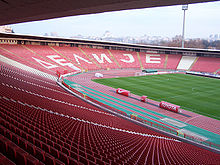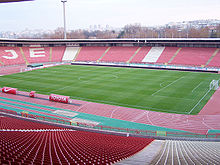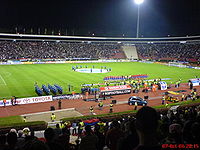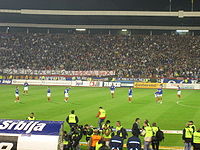- Stadion FK Crvena Zvezda
-
Stadion FK Crvena Zvezda Marakana 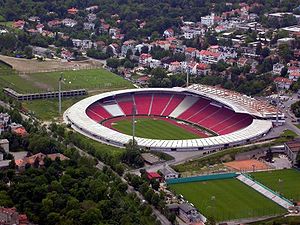
An aerial view of the stadium.Full name Marakana
(Red Star Stadium)Location Belgrade, Serbia Built 1960-1963 Opened 1 September 1963 Owner Red Star Belgrade Capacity 55,538 Field dimensions 100 x 68 meters Tenants Red Star Belgrade
Serbia national football teamThe Red Star Stadium (Serbian: Стадион Црвена Звезда/Stadion Crvena Zvezda) is a multi-use stadium in Belgrade, Serbia. It is currently used mostly for football matches and is the home stadium of Red Star Belgrade. The stadium is all-seated and the capacity is 55,538.[1] It was opened in 1963 after construction which had started three years earlier.
Contents
History
The first football stadium in this location was constructed in 1927. It was the stadium of SK Jugoslavija. It consisted of a 30,000 capacity stadium with grass pitch, athletic track, training facility and club house. SK Jugoslavija played its matches on the stadium until the end of the Second World War when the club was disbanded by the new Yugoslav authorities. The ground was signed over to the newly founded club Red Star Belgrade.
The Old Ground
On 27 December 1959, Red Star played its last match at the old ground. FK Novi Sad was the opposition in a farewell game at the dilapidated arena.
Together with the crumbling facility, a part of football history had left as well. At that stadium Moša Marjanović scored a famous goal on the Spanish keeper Ricardo Zamora, also František Plánička was defeated, and after World War II plenty of beautiful and exciting games were played.
After the farewell game, stadium was demolished to be replaced by the modern new sporting facility at exactly the same spot. In order to prepare the adequate construction area for the new stadium that was to be 12 meters lower than the previous one, over 350,000 cubic metres of soil and 15,000 cubic metres of stone had to be excavated.
Marakana
After three years of construction, the new stadium was ready to be unveiled. The official opening took place on 1 September 1963 with the Yugoslav First League match against NK Rijeka (2:1). That day, some 55,000 spectators came through 9 entrance gates of 5 metres width each into the still unfinished stands. The very first visitor to the stadium is known to be Laza Petrović, a peasant from the Loznica vicinity. This fiery Red Star fan arrived to the new stadium early in the morning and took his place in the eastern stand. He took out cheese and a bannock from his bag, then ate his breakfast while he waited patiently until the late afternoon for the game to start.
The largest crowd was recorded that autumn at a derby against FK Partizan – 74,000 people. Next year, after the stadium was fully completed its capacity increased to 110,000 spectators and it got the unofficial moniker - Marakana, in honour of the famous Brazilian stadium. Apart from the exciting look, the new stadium also featured a magnificent grass pitch with drainage, which made the overall playing experience much more enjoyable.
First official goal at the stadium was scored by Trifun Mihajlović in a youth match between Red Star and Jedinstvo from Zemun, a prelude to the first league match with NK Rijeka. First official top division goal is a deed of Vukoja from Rijeka while Dušan Maravić scored Red Star's first ever goal at stadium with the tying effort in the same game.
Still on the subject of records, according to the number of tickets sold, stadium saw its largest crowd on 23 April 1975 at the Cup Winners Cup semi-final home leg against the Hungarian side Ferencváros 2–2. There were officially 96,070 spectators in the stands that night with purchased tickets, but it is believed that the stadium was filled to the maximum allowable capacity which at the time was 110,000.
In the years since, the stadium's capacity was gradually decreased. Following different modernisation touch-ups more seats were put in each time. During mid 1990s in order to meet UEFA demands for spectators' comfort and security, standing places at the stadium were completely done away with. Seats were installed on all 4 stands so that the stadium‘s maximum capacity today reaches 60,000.
In 2008, the club announced the reconstruction of the pitch in the stadium. Under-soil grass heaters were installed and new modern turf has replaced the old playing surface. The training pitch will also be renovated by laying down synthetic turf and installing new lighting equipment.
New Stadium
In May 2010, Red Star presented a new stadium project. It will feature 60,000-70,000 seats. The Portuguese architect said "We tried to make this stadium known as the Red Star stadium. That's why we designed the main stadium structure in the form of pentagonal star, which is the club's symbol. The highest architectural standards will be applied to the entire complex. Steel, glass and natural materials will be used to achieve a modern and innovative architectural solutions to make the Red Star complex a unique and distinctive signiture of Belgrade."
Notable matches
Serbia plays Belgium at Marakana, October 7, 2006
- European Champions Cup season 1972/1973 final between Ajax and Juventus (1:0) on 30 May 1973, is among the record attendances on Belgrade’s Marakana. There were 91,564 spectators in the stands (the third highest attendance on the stadium's official all-time list), who came out to see the European football stars of the day such as Ruud Krol, Johan Neeskens, Johnny Rep, Johan Cruijff, Dino Zoff, Fabio Capello, José Altafini, Roberto Bettega, and others.[2]
- Another major international football competition was played at Red Star’s stadium – 1976 UEFA European Football Championship. Marakana actually hosted two memorable matches: the semi-final, which Yugoslavia lost 2:4 in heartbreaking fashion to West Germany in extra-time after leading 2:0 for much of the game, and the final on 20 June 1976 that saw Czechoslovakia upset West Germany 5-3 on penalties, after the game was deadlocked a 2:2 tie following extra time. The winning penalty was scored by Antonín Panenka who cheekily sliced the ball down the middle.
- On 24 April 1991, Red Star Belgrade and Bayern Munich contested a European Champions Cup semifinal tie. Since Red Star held a 2-1 advantage from the away game in Munich, atmosphere before the home leg was electric as fans could almost taste the big European final for the first time in club history. Naturally, the stadium was packed with about 100,000 people and when Siniša Mihajlović scored a trade mark free-kick goal for 1-0 on the night, progression to the big final seemed a foregone conclusion. But, in true German football style, Bayern came back with two quick second half goals to level the aggregate score. Finally, deep into injury time when the game seemed destined for extra period, a harmless looking Mihajlović cross into the box got deflected upwards by defender Klaus Augenthaler and subsequently misjudged by Bayern goalie Raimond Aumann - 2:2 on the night and Red Star goes through. The final whistle sparked off a huge celebration inside the stadium as well as a massive celebratory pitch invasion.
- In the Autumn of 1996, Red Star hosted 1. FC Kaiserslautern and FC Barcelona as part of its round of 32 and round of 16, respectively, Cup Winners' Cup ties. The significance of the matches was in the fact that after more than four years of sporting embargo and almost six years since the historic European Champions Cup title, Red Star was again competing among the European elite. Against Kaiserslaturn, they were 0-1 down after first leg, but managed to go through in extra time at Marakana on 26 September 1996 due to an inspired display by 18-year-old Dejan Stanković and 19-year-old Perica Ognjenović. The next round brought powerhouse Barça team featuring the likes of Ronaldo, Hristo Stoichkov, and Luís Figo, and Red Star was simply hoping for a miracle in the pressure-free underdog role. First leg 1-3 defeat at Camp Nou provided some hope for the return leg at home, and Zoran Jovičić's diving header just after halftime for 1-0 further buyoed the large crowd. However, enthusiasm was quickly deflated due to quick Barça response one minute later through Giovanni. After that, confident Barça stars comfortably held on for a 1-1 draw. The match is remembered for its carneval atmosphere as well as the never before seen tifo display (fan choreography) that saw all four Marakana stands covered in retractable flags, banners and mosaics.
- On 12 October 2005, the national team of Serbia-Montenegro played a deciding match on the last matchday of 2006 World Cup qualifying versus Bosnia-Herzegovina. The circumstances and high stakes made this an extremely important clash for Serbia. Not to mention the fact that both nations were parts of SFR Yugoslavia, which further raised the tensions. Going into the last matchday, Serbia-Montenegro was top of the group - two points ahead of second placed Spain and three points in spare compared to the third placed Bosnia-Herzegovina. Spain, however, was to play the minnows of the group San Marino and was virtually assured a win. With such highly probable scenario in the Spanish game, Serbia-Bosnia clash in Belgrade gained extra significance. The points advantage on top seemingly gave Serbia an advantage, but they still almost certainly needed a win because the math was mind-boggling. If the Belgrade score was to be tied, Serbia and Spain would then be equal on points at the top of the group and their two previous matches would have to decide who gets the first spot and automatic qualification. However, both of those games ended in ties (0-0 in Belgrade, 1-1 in Madrid), and according to FIFA rules, unlike UEFA's, away goals count for nothing, so goal difference would be the next deciding factor. That meant that if Bosnia managed to get a tie in Belgrade and Spain beat San Marino by a 4 goal margin, the Spaniards would be on top and Serbia would go into the playoffs. Bosnia was also not without a chance - if it managed to beat Serbia by any score in Belgrade, it would've become tied on points with Serbia, but would overtake it because the first match in Sarajevo ended in a 0-0 tie. Right from the start the tensions were extremely high, the stadium was packed with ultra-nationalist Serbs from Republika Srpska who came to cheer on Serbia, as well as visiting Bosnian fans. Mateja Kežman put the Serbs up in 7th minute, and the lead was not relinquished until the end. Serbia-Montenegro qualified directly for Germany 2006, sparking jubilant scenes all over Serbia & Montenegro.
- On 25 October 2007, Red Star hosted FC Bayern Munich in a UEFA Cup Group F match. Red Star Belgrade supporters left the stadium with a feeling of great frustration, because although their team were a goal up twice, then they conceded two goals in the last minutes of the game and lost 2-3. Red Star Belgrade then went on to lose its remaining three matches and finished at the bottom of Group F with 0 points. The atmosphere on the "Marakana" was incredible, with the 45,000 fans present on the stadium resembling the atmosphere of 1990-91 European Cup semifinal between these two teams.
Concerts
Marakana has seldom been used as a concert venue in its 45-year history.
The most notable performer is Zdravko Čolić who held massive shows at Marakana on three separate occasions. The first was on September 5, 1978 as part of his now famous Putujući Urnebes Tour - 70,000 people showed up. Then, almost 23 years later on June 31, 2001, he made anther appearance promoting his Okano album in front of 85,000 spectators. Finally on June 23, 2007 he promoted his Zavičaj album with another huge concert at Marakana.
Other than him, Serbian folk singer Ceca held a huge concert on June 15, 2002.
See also
- List of football stadiums in Serbia
References
- ^ [1]
- ^ Ajax-Juventus 1:0; 1973 European Cup Final
External links
- FC Red Star Belgrade
- Stadium pictures on Delije web site
- Stadium Guide Article
- 360° Marakana Virtual tour
Red Star Belgrade The Club · Stadium · Seasons · Red Star in Europe · Coaches · Players · 1991 European Cup Final · SupportersPreceded by
De Kuip
RotterdamEuropean Cup
Final Venue
1973Succeeded by
Heysel Stadium
BrusselsPreceded by
King Baudouin Stadium
BrusselsUEFA European Football Championship
Final Venue
1976Succeeded by
Stadio Olimpico
RomeCoordinates: 44°46′59.52″N 20°27′53.69″E / 44.7832°N 20.4649139°E
Categories:- Football venues in Serbia
- Athletics (track and field) venues
- Sport in Belgrade
- National stadiums
- Red Star Belgrade
Wikimedia Foundation. 2010.

